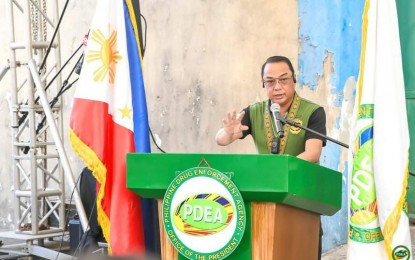
Philippine Drug Enforcement Agency Director General Wilkins Villanueva (File photo courtesy of PDEA)
MANILA – Philippine Drug Enforcement Agency (PDEA) Director General Wilkins Villanueva on Sunday admitted that he tested positive for coronavirus disease 2019 (Covid-19).
"As I was preparing for the Senate inquiry on Monday, I took my RT-PCR (reverse transcription polymerase chain reaction) at the Chinese General Hospital yesterday as part of the requirement. This morning, I received the result. I tested positive," Villanueva said in his social media post.
He apologized to the people he came in contact with during the last few days and asked them to take the necessary precaution. He said he would go on isolation in the following days.
Villanueva is set to attend the Senate inquiry on the bloody shootout between the police and PDEA agents in Quezon City on Feb. 24 which resulted in the killing of four people.
Philippine National Police chief Gen. Debold Sinas was also set to attend but he also tested positive of the virus last Thursday.
Meanwhile, PNP officer in charge Lt. Gen. Guillermo Eleazar said the Health Service is now checking the personnel of units visited by Sinas from March 9 to 11.
“Based on the guidance of our Chief PNP, Gen. Debold Sinas, all our personnel who made close contact with him must be checked as a matter of protocol and for their health safety and the safety of their family,” Eleazar told reporters.
He said the PNP, through the Public Information Office headed by Brig. Gen. Ildebrandi Usana, has coordinated with the PNP Press Corps for contact tracing of all its members who attended an activity with Sinas last March 10 in Camp Crame, Quezon City.
“We expect those who made close contact to strictly observe the healthy safety protocol such as physical distancing and wearing of face masks and face shields because these measures are proven to be effective in preventing the spread of the virus,” Eleazar said.
Based on the contact tracing protocol issued by Eleazar for the PNP in January this year, close contacts are classified into two -- the high-risk and the low-risk. The classification will be done after the health assessment that would be conducted by medical personnel of the PNP.
“All close contacts will be subjected to health assessment of our medical personnel. It is after this health assessment that our medical personnel would determine if those who made close contacts are high-risks or low-risks,” Eleazar said.
High-risk close contacts are those who did not observe the minimum health safety protocol including the wearing of face masks and face shields and observance of physical distancing when they got near a Covid-19-positive person.
Low risk close contacts, on the other hand, are those who observed the minimum health safety standards during close contact with an infected person.
For the high-risk close contacts, Eleazar said they are mandated to report to a quarantine facility of the PNP where they would be subjected to health assessment and strict observation by quarantine facility personnel.
They will only be allowed to leave the quarantine facility once cleared by medical personnel.
The low-risk close contacts, on the other hand, can still report to their respective offices but they are mandated to strictly observe the minimum health safety standard protocol, and their compliance will be strictly monitored by the Station Health Units or the designated administrative officer of their respective units and offices. (PNA)
